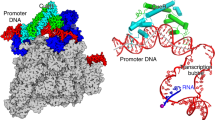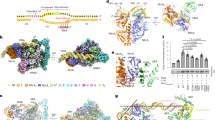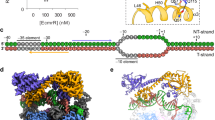Abstract
RECENT discoveries of activator proteins that distort DNA but bear no obvious activation domains have focused attention on the role of DNA structure in transcriptional regulation1. Here we describe how the transcription factor MerR can mediate repression as well as activation through stereospecific modulation of DNA structure. The represser form of MerR binds between the –10 and –35 promoter elements of the bacterial mercury-detoxification genes, PT, allowing RNA polymerase to form an inactive complex with PT and MerR at this stress-inducible promoter2,3. Upon mercuric ion binding, Hg–MerR converts this polymerase complex into the transcriptionally active or 'open' form2–4. We show here that MerR bends DNA towards itself in a manner similar to the bacterial catabolite-activator protein CAP, namely at two loci demarked by DNase I sensitivity, and that the activator conformation, Hg–MerR, relaxes these bends. This activator-induced unbending, when coupled with the previously described untwisting of the operator5, remodels the promoter and makes it a better template for the poised polymerase.
This is a preview of subscription content, access via your institution
Access options
Subscribe to this journal
Receive 51 print issues and online access
$199.00 per year
only $3.90 per issue
Buy this article
- Purchase on Springer Link
- Instant access to full article PDF
Prices may be subject to local taxes which are calculated during checkout
Similar content being viewed by others
References
Tjian, R. & Maniatis, T. Cell 77, 5–8 (1994).
Frantz, B. & O'Halloran, T. V. Biochemistry 29, 4747–4751 (1990).
Heltzel, A., Lee, I. W., Totis, P. A. & Summers, A. O. Biochemistry 29, 9572–9584 (1990).
O'Halloran, T. V., Frantz, B., Shin, M. K., Ralston, D. M. & Wright, J. G. Cell 56, 119–129 (1989).
Ansari, A. Z., Chael, M. L. & O'Halloran, T. V. Nature 355, 87–89 (1992).
Comess, K. M., Shewchuk, L. M., Ivanetich, K. & Walsh, C. T. Biochemistry 33, 4175–4186 (1994).
Parkhill, J. & Brown, N. L. Nucleic Acids Res. 18, 5157–5162 (1990).
Parkhill, J., Ansari, A. Z., Wright, J., Brown, N. L. & O'Halloran, T. V. EMBO J. 12, 413–421 (1993).
Ansari, A. Z. & O'Halloran, T. V. in Transcription: Mechanisms and Regulation (eds Conaway, R. C. & Conaway, J. W.) 369–386 (Raven, New York, 1994).
Zinkel, S. S. & Crothers, D. M. Nature 328, 178–181 (1987).
Salvo, J. J. & Grindley, N. D. F. Nucleic Acids Res. 15, 9771–9779 (1987).
Crothers, D. M., Gartenberg, M. R. & Shrader, T. E. Meth. Enzym. 208, 118–146 (1991).
Drak, J. & Crothers, D. M. Proc. natn. Acad. Sci. U.S.A. 88, 3074–3078 (1991).
Kahn, J. D., Yun, E. & Crothers, D. M. Nature 368, 163–166 (1994).
Lahm, A., Weston, S. A. & Suck, D. Nucleic Acids molec. Biol. 5, 171–186 (1991).
Hogan, M. E., Roberson, M. W. & Austin, R. H. Proc. natn. Acad. Sci. U.S.A. 86, 9273–9277 (1989).
Travers, A. A. & Klug, A. in DNA Topology an its Biological Effects (eds Cozzarelli, N. R. & Wang, J. C.) 57–106 (Cold Spring Harbor Laboratory Press, Cold Spring Harbor, 1990).
Gaston, K., Bell, A., Kolb, A., Buc, H. & Busby, S. Cell 62, 733–743 (1990).
Schultz, S. C., Shields, G. C. & Steitz, T. A. Science 253, 1001–1007 (1991).
Raumann, B. E., Rould, M. A., Pabo, C. O. & Sauer, R. T. Nature 367, 754–757 (1994).
Burkhoff, A. M. & Tullius, T. D. Nature 331, 455–457 (1989).
Hunter, C. A. J. molec. Biol. 256, 1025–1054 (1993).
Cozzarelli, N. R., Boles, T. C. & White, J. H. in DNA Topology and its Biological Effects (eds Cozzarelli, N. R. & Wang, J. C.) 139–184 (Cold Spring Harbor Laboratory Press, Cold Spring Harbor, New York, 1990).
Ptashne, M. in A Genetic Switch 13–123 (Cell press & Blackwell Scientific, Cambridge, MA, 1986).
Wang, L., Helmann, J. D. & Winans, S. C. Cell 69, 659–667 (1992).
Storz, G., Tartaglia, L. A. & Ames, B. N. Science 248, 189–194 (1990).
Hidalgo, E. & Demple, B. EMBO J. 13, 138–146 (1993).
Snyder, U. K., Thompson, J. F. & Landy, A. Nature 341, 255–257 (1989).
Ross, W., Park, S.-J. & Summers, A. O. J. Bact. 171, 4009–4018 (1989).
Boroweic, J. A. & Gralla, J. D. Biochemistry 25, 5051–5057 (1986).
Müller, H.-P. & Varmus, H. E. EMBO J. 13, 4704–4714 (1994).
Author information
Authors and Affiliations
Rights and permissions
About this article
Cite this article
Ansari, A., Bradner, J. & O'Halloran, T. DNA-bend modulation in a repressor-to-activator switching mechanism. Nature 374, 370–375 (1995). https://doi.org/10.1038/374370a0
Received:
Accepted:
Issue Date:
DOI: https://doi.org/10.1038/374370a0
This article is cited by
-
CueR activates transcription through a DNA distortion mechanism
Nature Chemical Biology (2021)
-
The bacterial multidrug resistance regulator BmrR distorts promoter DNA to activate transcription
Nature Communications (2020)
-
Structural Analysis of the Hg(II)-Regulatory Protein Tn501 MerR from Pseudomonas aeruginosa
Scientific Reports (2016)
-
Mercurial-resistance determinants in Pseudomonas strain K-62 plasmid pMR68
AMB Express (2013)
-
Bacterial gold sensing and resistance
BioMetals (2011)
Comments
By submitting a comment you agree to abide by our Terms and Community Guidelines. If you find something abusive or that does not comply with our terms or guidelines please flag it as inappropriate.



